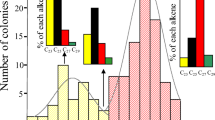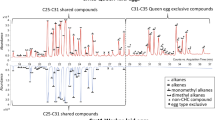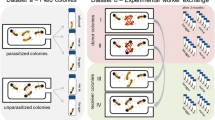Abstract
Chemical cues are among the most important information-sharing mechanisms in insect societies, in which cuticular hydrocarbons play a central role, e.g., from nestmate recognition to queen signaling. The nestmate recognition mechanism usually prevents intruders from taking advantage of the resources stored in the nest. However, nestmate recognition is not unconditionally effective, and foreign individuals can sometimes infiltrate unrelated nests and take advantage of the colony resources. In this study, we investigated the role of overall colony odor profiles on the ability of conspecific workers to drift into unrelated colonies. We hypothesized that drifters would have higher chances of success by infiltrating colonies with the odor profiles most similar to their own nest, avoiding being detected as non-nestmates. By performing a drifting bioassay, we found that workers of the ant Formica fusca infiltrated unrelated conspecific colonies at a rate of 2.4%, significantly infiltrating colonies displaying CHC profiles most similar to their natal nests. Notably, methyl branched hydrocarbons seem to play a role as recognition cues in this species. In addition, we show that environmental rather than genetic factors are responsible for most contributions on the CHC phenotype, presenting ca. of 50% and 27.5% of explained variation respectively, and playing a major role in how worker ants detect and prevent the infiltration of non-nestmates in the colony. Hence, relying on cuticular hydrocarbons similarities could be a profitably evolutionary strategy by which workers can identify conspecific colonies, evade detection by guards, and avoid competition with genetic relatives.





Similar content being viewed by others
Data Availability
The raw datasets and R scripts used in this manuscript are available at Mendeley Data Repository (Oliveira et al. 2021).
References
Aitchison J (1982) The statistical-analysis of compositional data. J Royal Statistic Soc Ser B-Methodol 44:139–177
Akino T (2008) Chemical strategies to deal with ants: a review of mimicry, camouflage, propaganda, and phytomimesis by ants (Hymenoptera: Formicidae) and other arthropods. Myrmecol News 11:173–181
Bargum K, Helanterä H, Sundström L (2007) Genetic population structure, queen supersedure and social polymorphism in a social Hymenoptera. J Evol Biol 20:1351–1360
Bates D, Maechler M, Bolker B, Walker S (2016) lme4: linear mixed-effects models using Eigen and S4. R package version 1.1-11 R news
Birmingham AL, Winston ML (2004) Orientation and drifting behaviour of bumblebees (Hymenoptera: Apidae) in commercial tomato greenhouses. Can J Zool 82:52–59. https://doi.org/10.1139/z03-201
Borowiec ML, Cover SP, Rabeling C (2021) The evolution of social parasitism in Formica ants revealed by a global phylogeny. Proc Natl Acad Sci U S A:118
Bourke AFG, Franks NR (1995) Social evolution in ants. Princeton University Press, Princeton
Brandt M, Foitzik S, Fischer-Blass B, Heinze J (2005) The coevolutionary dynamics of obligate ant social parasite systems—between prudence and antagonism. Biol Rev 80:251–267
Chapman NC, Beekman M, Oldroyd BP (2009a) Worker reproductive parasitism and drift in the western honeybee Apis mellifera. Behav Ecol Sociobiol 64:419–427. https://doi.org/10.1007/s00265-009-0858-7
Chapman NC, Higgs JS, Wattanachaiyingcharoen W, Beekman M, Oldroyd BP (2009b) Worker reproductive parasitism in naturally orphaned colonies of the Asian red dwarf honey bee, Apis florea. Ins soc 57:163–167. https://doi.org/10.1007/s00040-009-0061-x
Chapman NC, Nanork P, Gloag RS, Wattanachaiyingcharoen W, Beekman M, Oldroyd BP (2009c) Queenless colonies of the Asian red dwarf honey bee (Apis florea) are infiltrated by workers from other queenless colonies. Behav Ecol 20:817–820. https://doi.org/10.1093/beheco/arp065
Dahbi A, Hefetz A, Cerdá X, Lenoir A (1999) Trophallaxis mediates uniformity of Colony odor in Cataglyphis iberica ants (Hymenoptera, Formicidae). J Insect Behav 12(559–567). https://doi.org/10.1023/a:1020975009450
Davies N, Bourke AF, Brooke ML (1989) Cuckoos and parasitic ants: interspecific brood parasitism as an evolutionary arms race. Trends Ecol Evol 4:274–278
Dettner K, Liepert C (1994) Chemical mimicry and camouflage. Annu Rev Entomol 39:129–154
Fiedler K, Hoelldobler B, Seufert P (1996) Butterflies and ants: the communicative domain. Experientia 52:14–24
Frizzi F, Ciofi C, Dapporto L, Natali C, Chelazzi G, Turillazzi S, Santini G (2015) The rules of aggression: how genetic, chemical and spatial factors affect intercolony fights in a dominant species, the mediterranean acrobat ant Crematogaster scutellaris. PLoS One 10:e0137919
Hamilton WD (1964a) The genetical evolution of social behaviour. I. J Theor Biol 7:1–16. https://doi.org/10.1016/0022-5193(64)90038-4
Hamilton WD (1964b) The genetical evolution of social behaviour. II. J Theor Biol 7:17–52. https://doi.org/10.1016/0022-5193(64)90039-6
Hannonen M, Sundström L (2003) Sociobiology: worker nepotism among polygynous ants. Nature 421:910–910
Hannonen M, Helantera H, Sundstrom L (2004) Habitat age, breeding system and kinship in the ant Formica fusca. Mol Ecol 13:1579–1588. https://doi.org/10.1111/j.1365-294X.2004.02136.x
Helanterä H, Sundström L (2007) Worker policing and nest mate recognition in the ant Formica fusca. Behav Ecol Sociobiol 61:1143–1149. https://doi.org/10.1007/s00265-006-0327-5
Helanterä H, Lee YR, Drijfhout FP, Martin SJ (2011) Genetic diversity, colony chemical phenotype, and nest mate recognition in the ant Formica fusca. Behav Ecol. https://doi.org/10.1093/beheco/arr037
Hlaváč P, Newton AF, Maruyama M (2011) World catalogue of the species of the tribe Lomechusini (Staphylinidae: Aleocharinae). Zootaxa 3075:1–151
Hölldobler B, Wilson EO (1990) The ants. Belknap Press
Hothorn T, Bretz F, Westfall P (2008) Simultaneous inference in general parametric models. Biom J 50:346–363
Johnson BR, van Wilgenburg E, Tsutsui ND (2011) Nestmate recognition in social insects: overcoming physiological constraints with collective decision making. Behav Ecol Sociobiol 65:935–944. https://doi.org/10.1007/s00265-010-1094-x
Katzerke A, Neumann P, Pirk CWW, Bliss P, Moritz RFA (2006) Seasonal nestmate recognition in the ant Formica exsecta. Behav Ecol Sociobiol 61:143–150. https://doi.org/10.1007/s00265-006-0245-6
Keller L, Ross KG (1998) Selfish genes: a green beard in the red fire ant. Nature 394:573–575
Lenoir A, D'Ettorre P, Errard C, Hefetz A (2001) Chemical ecology and social parasitism in ants. Annu Rev Entomol 46:573–599. https://doi.org/10.1146/annurev.ento.46.1.573
Leonhardt SD, Rasmussen C, Schmitt T (2013) Genes versus environment: geography and phylogenetic relationships shape the chemical profiles of stingless bees on a global scale. Proc R Soc Lond B Biol Sci 280:20130680
Liersch S, Schmid-Hempel P (1998) Genetic variation within social insect colonies reduces parasite load. Proc R Soc Lond B Biol Sci 265:221–225
Lopez-Vaamonde C, Koning JW, Brown RM, Jordan WC, Bourke AFG (2004) Social parasitism by male-producing reproductive workers in a eusocial insect. Nature 430:557–560. https://doi.org/10.1038/Nature02769
Martin SJ, Helanterä H, Drijfhout FP (2008) Colony-specific hydrocarbons identify nest mates in two species of Formica ant. J Chem Ecol 34:1072–1080. https://doi.org/10.1007/s10886-008-9482-7
Meunier J, Delemont O, Lucas C (2011) Recognition in ants: social origin matters. PLoS One 6:e19347. https://doi.org/10.1371/journal.pone.0019347
Mori A, Grasso DA, Le Moli F (2000) Raiding and foraging behavior of the blood-red ant, Formica sanguinea Latr. (Hymenoptera, Formicidae). J Insect Behav 13:421–438
Muñoz F, Sanchez L (2019) Frequentist and Bayesian methods for breeders, quantitative geneticists and forest genetic resources analysts, 0.12–4 edn.,
Nanork P, Paar J, Chapman NC, Wongsiri S, Oldroyd BP (2005) Entomology: Asian honeybees parasitize the future dead. Nature 437:829. https://doi.org/10.1038/437829a
Nanork P, Chapman NC, Wongsiri S, Lim J, Gloag RS, Oldroyd BP (2007) Social parasitism by workers in queenless and queenright Apis cerana colonies. Mol Ecol 16:1107–1114. https://doi.org/10.1111/j.1365-294X.2006.03207.x
Nash DR, Boomsma JJ (2008) Communication between hosts and social parasites. In: Hughes PED (ed) Sociobiology of communication: an interdisciplinary perspective. Oxford University Press, Oxford, pp 55–79
Oksanen J, Kindt R, Legendre P, O’Hara B, Stevens MHH, Oksanen MJ, Suggests M (2007) The vegan package Community ecology package:631–637
Oliveira RC, Oi CA, Vollet-Neto A, Wenseleers T (2016) Intraspecific worker parasitism in the common wasp, Vespula vulgaris. Anim Behav 113:79–85. https://doi.org/10.1016/j.anbehav.2015.12.025
Oliveira RC, van Zweden J, Wenseleers T (2021) Similarities in recognition cues lead to the infiltration of non-nestmates in an ant species, V1 edn., Mendeley Data. https://doi.org/10.17632/stfbjy4vf7.1
Pérez-Lachaud G, Valenzuela JE, Lachaud J-P (2011) Is increased resistance to parasitism at the origin of polygyny in a Mexican population of the ant Ectatomma tuberculatum (Hymenoptera: Formicidae)? Fla Entomol 94:677–684
Petrie M, Møller A (1991) Laying eggs in others' nests: intraspecific brood parasitism in birds. Trends Ecol Evol 6:315–320
R Core Team (2020) R: A language and environment for statistical computing, R-4.0.0 edn. R Foundation for Statistical Computing, Vienna
Ratnieks FLW, Visscher PK (1989) Worker policing in the honeybee. Nature 342:796–797. https://doi.org/10.1038/342796a0
Ratnieks FL, Wenseleers T (2005) Evolution. Policing insect societies. Science 307:54–56. https://doi.org/10.1126/science.1106934
Ripley B, Venables B, Bates DM, Hornik K, Gebhardt A, Firth D, Ripley MB (2013) Package ‘MASS’ CRAN Repository http://cran.r-project.org/web/packages/MASS/MASS.pdf
Schmid-Hempel P, Crozier RH (1999) Ployandry versus polygyny versus parasites. Philos Trans R Soc Lond Ser B Biol Sci 354:507–515
Shykoff JA, Schmid-Hempel P (1991) Parasites and the advantage of genetic variability within social insect colonies. Proc R Soc Lond B Biol Sci 243:55–58
Soroker V, Fresneau D, Hefetz A (1998) Formation of colony odor in ponerine ant Pachycondyla apicalis. J Chem Ecol 24:1077–1090
Sumner S, Lucas E, Barker J, Isaac N (2007) Radio-tagging technology reveals extreme nest-drifting behavior in a eusocial insect. Curr Biol 17:140–145. https://doi.org/10.1016/j.cub.2006.11.064
Takahashi J-i, Martin SJ, Ono M, Shimizu I (2010) Male production by non-natal workers in the bumblebee, Bombus deuteronymus (Hymenoptera: Apidae). J Ethol 28:61–66
Tschinkel WR (1996) A newly-discovered mode of colony founding among fire ants. Ins soc 43:267–276. https://doi.org/10.1007/bf01242928
van Zweden J, d'Ettore P (2010) Nestmate recognition in social insects and the role of hydrocarbons. In: Blomquist GJ (ed) Insect hydrocarbons biology, biochemistry, and chemical ecology. Cambridge University Press, Cambridge, pp 222–243
Wenseleers T, Ratnieks FLW (2006) Comparative analysis of worker reproduction and policing in eusocial hymenoptera supports relatedness theory. Am Nat 168:E163–E179. https://doi.org/10.1086/508619
Wilson EO (1971) The insect societies. Belknap Press
Wilson EO (1987) Causes of ecological success: the case of the ants. J Anim Ecol 56:1–9
Wilson AJ et al (2010) An ecologist’s guide to the animal model. J Anim Ecol 79:13–26
Zanette LRS, Miller SDL, Faria CMA, Lopez-Vaamonde C, Bourke AFG (2014) Bumble bee workers drift to conspecific nests at field scales. Ecol Entomol 39:347–354. https://doi.org/10.1111/een.12109
Funding
R.C.O. was supported by a grant from CNPq-Brazil (238127/2012–5) and Research Foundation Flanders (Research Grant 1502119 N and Postdoctoral Fellowship 12R9619N). J.V.Z. was supported by a FWO Postdoctoral Fellowship (12Q7615N).
Author information
Authors and Affiliations
Contributions
R.C.O and J.V.Z. had the original idea. R.C.O. performed the experiments. R.C.O, T.W. and J.V.Z. analyzed the data. R.C.O. wrote the first draft of the manuscript. All authors edited and revised the manuscript.
Corresponding author
Ethics declarations
Conflicts of Interest/Competing Interests
The authors declare that they have no competing interests.
Supplementary Information
ESM 1
(PDF 249 kb)
Rights and permissions
About this article
Cite this article
Caliari Oliveira, R., van Zweden, J. & Wenseleers, T. Similarities in Recognition Cues Lead to the Infiltration of Non-Nestmates in an Ant Species. J Chem Ecol 48, 16–26 (2022). https://doi.org/10.1007/s10886-021-01325-3
Received:
Revised:
Accepted:
Published:
Issue Date:
DOI: https://doi.org/10.1007/s10886-021-01325-3




